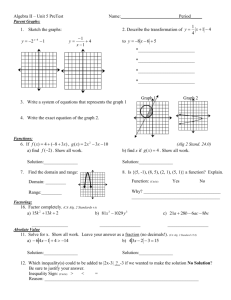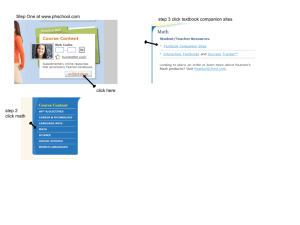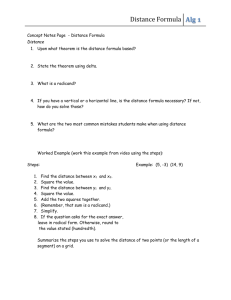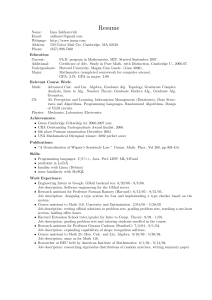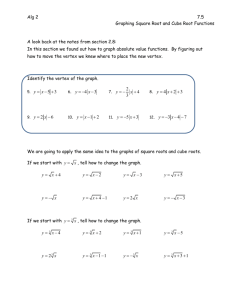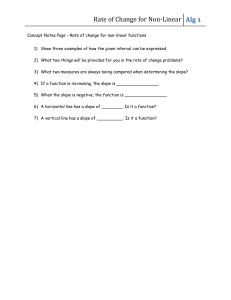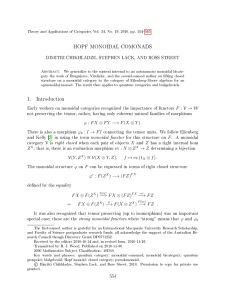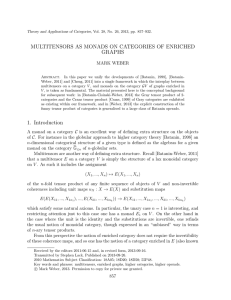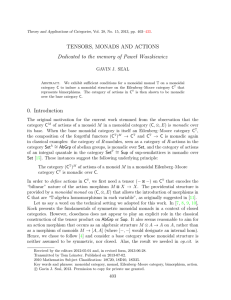OPMONOIDAL MONADS PADDY MCCRUDDEN
advertisement
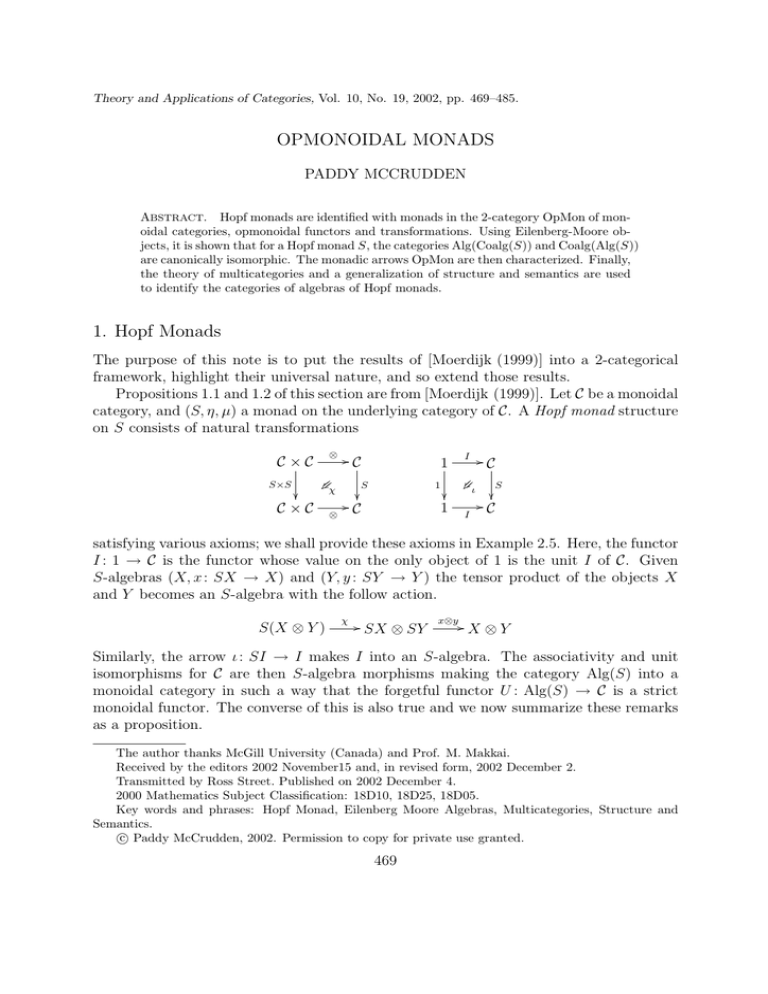
Theory and Applications of Categories, Vol. 10, No. 19, 2002, pp. 469–485.
OPMONOIDAL MONADS
PADDY MCCRUDDEN
ABSTRACT. Hopf monads are identified with monads in the 2-category OpMon of monoidal categories, opmonoidal functors and transformations. Using Eilenberg-Moore objects, it is shown that for a Hopf monad S, the categories Alg(Coalg(S)) and Coalg(Alg(S))
are canonically isomorphic. The monadic arrows OpMon are then characterized. Finally,
the theory of multicategories and a generalization of structure and semantics are used
to identify the categories of algebras of Hopf monads.
1. Hopf Monads
The purpose of this note is to put the results of [Moerdijk (1999)] into a 2-categorical
framework, highlight their universal nature, and so extend those results.
Propositions 1.1 and 1.2 of this section are from [Moerdijk (1999)]. Let C be a monoidal
category, and (S, η, µ) a monad on the underlying category of C. A Hopf monad structure
on S consists of natural transformations
⊗
C×C
S×S
/C
x yyyyχ
C×C
1
1
S
/C
⊗
1
I
| ι
I
/C
S
/C
satisfying various axioms; we shall provide these axioms in Example 2.5. Here, the functor
I : 1 → C is the functor whose value on the only object of 1 is the unit I of C. Given
S-algebras (X, x : SX → X) and (Y, y : SY → Y ) the tensor product of the objects X
and Y becomes an S-algebra with the follow action.
S(X ⊗ Y )
χ
/ SX ⊗ SY x⊗y / X ⊗ Y
Similarly, the arrow ι : SI → I makes I into an S-algebra. The associativity and unit
isomorphisms for C are then S-algebra morphisms making the category Alg(S) into a
monoidal category in such a way that the forgetful functor U : Alg(S) → C is a strict
monoidal functor. The converse of this is also true and we now summarize these remarks
as a proposition.
The author thanks McGill University (Canada) and Prof. M. Makkai.
Received by the editors 2002 November15 and, in revised form, 2002 December 2.
Transmitted by Ross Street. Published on 2002 December 4.
2000 Mathematics Subject Classification: 18D10, 18D25, 18D05.
Key words and phrases: Hopf Monad, Eilenberg Moore Algebras, Multicategories, Structure and
Semantics.
c Paddy McCrudden, 2002. Permission to copy for private use granted.
469
470
PADDY MCCRUDDEN
1.1. Proposition. There is a bijection between Hopf monad structures on a monad S
and monoidal structures on Alg(S) such that the forgetful functor U : Alg(S) → C is a
strict monoidal functor.
Suppose (C, δ, ε) is a coalgebra in C. Observe that the arrows
SC
Sδ
/ S(C ⊗ C)
χ
/ SC ⊗ SC
Sε
SC
/ SI
ι
/I
make SC into a coalgebra in C. In fact, there is a monad Coalg(S) on the category
Coalg(C) of coalgebras in C lifting the monad S.
1.2. Proposition. The categories Alg(Coalg(S)) and Coalg(Alg(S)) are canonically
isomorphic.
The aim of this note is to analyze and generalize Propositions 1.1 and 1.2. We shall
first consider Proposition 1.2.
2. Monads in a 2-category
In this section we recall the notion of a monad in a 2-category and then provide some
examples. We then consider monadicity for arrows in a 2-category, and characterize the
monadic arrows in the 2-category OpMon. We shall then show that Proposition 1.2 is a
consequence of the fact that representable 2-functors preserve Eilenberg-Moore objects.
Let K be a bicategory. A monad [Street (1972)] in K is a lax functor 1 → K from the
terminal 2-category 1. It amounts to an object X of K equipped with an arrow T : X → X
and two 2-cells,
X AA
}>
}} µ AAAT
}
AA
}}
A
}}
/X
X
T
T
1
X
η
'
7X
T
called the multiplication and unit respectively, satisfying three axioms that express that
µ is associative and unital. We also say that T is a monad on the object X. Given
monads S and S on X, a monad morphism f : S → S is a 2-cell α : S ⇒ S respecting
the multiplication and unit. Note the change of direction. With the evident compositions
there is a category Mnd(X) of monads on X. This category is in fact a subcategory of
the underlying category of the 2-category of monads in K [Street (1972)].
2.1. Example. Ordinary Monads. A monad in the 2-category Cat of categories is of
course a monad in the usual sense.
2.2. Example. Monoids. For a monoidal category C, there is a bicategory ΣC called
the suspension of C. The bicategory ΣC has one object 0 and ΣC(0, 0) = C, and with
composition given by the monoidal structure. A monad in ΣC is exactly a monoid in C.
471
OPMONOIDAL MONADS
2.3. Example. Categories. Recall the bicategory Span(Set) of spans of sets. An object
is a set, an arrow is a span A ← B → C of sets. The set B is called the head of the
span, and the arrows are called the left and right legs. A 2-cell is a function between the
heads commuting with the legs. Composition is given by pullback, and the identity span
is given by the span of identity functions. A monad in Span(Set) is exactly a category
[Bénabou (1967)].
2.4. Example. Multicategories. Multicategories were introduced in [Lambek (1969)]
and have experienced a resurgence of interest of late. A multicategory is a monad in the
Kleisli bicategory SpanT (Set) of spans, where T is the cartesian free monoid monad on the
category Set of sets [Leinster (1997), Hermida (1999)]. We shall return to multicategories
in Section 3.
For monoidal categories C and D, an opmonoidal functor F : C → D is a functor
F : C → D along with natural transformations
C×C
F ×F
D×D
⊗
/C
w wwwwχ
⊗
1
F
/D
1
1
I
{ ι
I
/C
F
/D
satisfying the following three axioms.
⊗
/C
? ??? F
????a
??
#
?
⊗
⊗1
χ
/ C2
D
C 3 ??
?? 2
?
??
?
F
?
{ χ1
??
??
⊗
F3
/ D2
D3
?C
1⊗
2
⊗1
⊗
/C
2
? C ? r
? ??? F
???
1I
??
#
?
1
1
/C
C ??
D
??
?
??
?
F
?
?
??
F ?
1
/D
D
1
⊗
/C
? ??? F
????l
??
#
?
1
1
/
C ??
C ??
D
?
??
??F
?
??
F ?
1
/
D
D
?C
I1
2
1
2
⊗
? C ?? 2
1⊗
??F
??
1χ
3
2
C ?? ?D
??
??
1⊗
F3
D3
⊗1
2
⊗
? C ?? 2
??F
1I
??
2
1ι
C ??
?D
??
?
F ?
1I
D
1
/C
??
??F
??
/D
⊗
?
????a
#
⊗
/ D2
{ χ
/C
??
??F
??
/D
?
⊗
????r
#
1
/D
{ χ
⊗
/C
2
??
? C ?? 2
??F
??F
I1
{
?
??
χ
?
/D
2
ι1
C ??
D
⊗
?
?
??
????l
#
??
F
I1
1
/D
D
1
472
PADDY MCCRUDDEN
Given parallel opmonoidal functors F and G, a transformation of opmonoidal functors
from F to G is a natural transformation α : F ⇒ G satisfying the following two axioms.
⊗
C2
sk χ
G2
/C
G
C2
I
sk ι
G
I
F
/C
⊗
I
1
/C
sk ι
1
F
/C
1
sk α
/C
sk χ
F2
C2
/C
1
2
α
ks
G2
F
/C
⊗
1
1
sk α
⊗
C2
F
/C
I
With the evident compositions there is a 2-category OpMon whose objects are monoidal
categories, whose arrows are opmonoidal functors and whose 2-cells are transformations
of opmonoidal functors. By [Kelly (1974b), Section 10.8], the 2-category OpMon is isomorphic to the 2-category Algc (T ) of algebras, colax morphisms and transformations for
some 2-monad T on Cat.
2.5. Example. Hopf monads. A Hopf Monad is exactly a monad in the 2-category
OpMon.
Following Example 2.5, we suggest the more descriptive term opmonoidal monad for
Hopf monad, which we shall use for the remainder of this paper.
2.6. Example. Bialgebras. Let B be a bialgebra in a symmetric monoidal category C.
Let S : C → C denote the endofunctor of C whose value on an object X is X ⊗ B. The
multiplication and unit of B induce natural transformations µ : SS ⇒ S and η : 1 ⇒ S
making S into a monad on C. The comultiplication, counit and symmetry induce natural
transformations
C×C
S×S
C×C
⊗
x yyyyχ
⊗
/C
/C
1
S
1
1
I
| ι
I
/C
S
/C
making S into an opmonoidal monad.
Recall that adjunctions and extensions may be be defined in any 2-category [Kelly & Street (1974),
Street & Walters (1978)]. Let K be a 2-category and G : L → K an arrow in K. A left
adjoint of G is an arrow F : K → L and two 2-cells η : 1 ⇒ GF and ε : F G ⇒ 1, called
the unit and counit respectively, satisfying εF ◦ F η = 1 and Gε ◦ ηG = 1. One calls F
the left adjoint of G. If H : L → N is an arrow with the same domain as G then the right
OPMONOIDAL MONADS
473
extension (also called the right Kan extension) of H along G is an arrow RanG H : K → N
and a 2-cell
~
~~
~
~
~ ~
G
K
L@
+3
@@
@@H
@@
/N
RanG H
such that for any J : K → N , the function
K(K, N )(J, RanF H) → K(L, N )(JG, H)
given by composing with this 2-cell is a bijection. Left adjoints and right extensions may
not always exist, but if they do, they are unique up to canonical isomorphism.
2.7. Lemma. [Street (1972), Theorem 4] If G : L → K is an arrow in a 2-category K
with a left adjoint F , and if ε : F G ⇒ 1 is the counit of the adjunction, then any arrow
H : L → N has a right extension along G given by the arrow HF : K → L and the 2-cell
Hε : HF G ⇒ H. This extension is preserved by any 2-functor.
2
Let G : L → K be an arrow such that the right extension R = RanG G of G along
itself exists. There are 2-cells µ : RR ⇒ R and η : 1 ⇒ R making R a monad in K
[Street (1972), Section 2]. We call R the monad generated by G. When G has a left
adjoint F we also say that R is generated by the adjunction F G.
We now turn to the notion of algebras for a monad. Let T be a monad in K and let Y
be an object of K. A Y -based T -algebra consists of an arrow M : Y → X equipped with
a 2-cell
> X AA
AA T
~~
~
~
µ AAAA
~~
~
~
/X
Y
M
M
satisfying two axioms that express that µ : T ◦ M ⇒ M is associative and unital. If M
and N are Y -based T -algebras, then a Y -based T -algebra morphism f : M → N is a
2-cell f : M ⇒ N in K satisfying one axiom, expressing that f respects the action of T .
With the evident compositions there is a category Alg(Y, T ) whose objects are Y -based
T -coalgebras, and whose arrows are Y -based T -algebra morphisms, and Alg(Y, T ) is the
value at the object Y of a 2-functor Alg(−, T ) : Kop → Cat. An Eilenberg-Moore object
of T is a representation
K(−, Alg(T )) ∼
= Alg(−, T )
of this 2-functor. This means that Alg(T ) is a T -algebra (U : Alg(T ) → X, µ) with a
1- and a 2-dimensional universal property. The 1-dimensional property states that if M
is a Y -based T -algebra then there exists a unique arrow cM : Y → Alg(T ), called the
474
PADDY MCCRUDDEN
comparison, such that the following equation holds.
X FF
x<
FF T
xx
FF
x
x
FF
x
F"
xx
/ Alg(T )
/X
> X AA
AA T
~~
~
AA
~~
AA
~
~
~
/X
Y
M
U
Y
cM
M
U
The 2-dimensional property states that if f : M → N is a morphism of Y -based T algebras, then there exists a unique 2-cell cf : cM ⇒ cN such that f = U ◦ cf . In
general, Eilenberg-Moore objects need not exist; one says that K admits the construction of Eilenberg-Moore objects if for all monads T in K there exists a representation of
Coalg(−, T ). The existence of Eilenberg-Moore objects is a completeness property of K.
Eilenberg-Moore objects are unique up to isomorphism, not just equivalence.
2.8. Example. Eilenberg-Moore Objects in Cat. It is well known that Eilenberg-Moore
objects exist in Cat. Explicitly, the category Alg(T ) has algebras (X, x : T X → X) as
objects, and algebra morphisms as arrows. The arrow U : Alg(T ) → X is the forgetful
functor, and the action
X FF
x<
xx
xx
x
xx
U
Alg(T )
µ
U
FF T
FF
FF
F"
/X
has component x at the object (X, x). Of course this category of algebras was known
before its universal property.
Suppose S is a monad in a 2-category K and F : K → L is a 2-functor. Then the arrow
FS is canonically a monad in L, and furthermore, F takes S-algebras to FS-algebras. In
particular, if the Eilenberg-Moore object Alg(S) of S exists, then FAlg(S) is canonically
an FS algebra. We say that F preserves the Eilenberg-Moore object of S if FAlg(S) is
an Eilenberg-Moore object of FS, and we say that F preserves Eilenberg-Moore objects
if it preserves all Eilenberg-Moore objects that exist. Any finite limit preserving functor
preserves Eilenberg-Moore objects.
Recall that an opmonoidal functor is called strong if the natural transformations χ
and ι are isomorphisms.
2.9. Proposition. The 2-category OpMon admits Eilenberg-Moore objects and the forgetful 2-functor U : OpMon → Cat preserves them. Moreover, for any monad S on C in
OpMon, the universal arrow U : Alg(S) → C is strong monoidal.
Proof. The 2-category OpMon is isomorphic to the 2-category Algc (D) of strict Dalgebras, colax morphism, and appropriate 2-cells for some 2-monad D on Cat. Lack
[Lack (1998)] shows that such 2-categories admit Eilenberg-Moore objects, that the forgetful 2-functor preserves them, and that the universal arrow U : Alg(S) → C is strong
monoidal.
OPMONOIDAL MONADS
475
2.10. Example. Reflection of Eilenberg-Moore objects. We show that the 2-functor
U : OpMon → Cat does not reflect Eilenberg-Moore objects. Let (Set∗ , +) and (Set∗ , ×)
be the category of pointed sets equipped with the monoidal structures deriving from coproduct and product respectively. The terminal object is also initial, providing canonical
arrows X + Y → X × Y and 0 → 1. These arrows equip the identity functor with
the structure of an opmonoidal functor M : (Set∗ , +) → (Set∗ , ×). The identity natural
transformation
(Set
, ×)
8 ∗ M
qq
M qqq
qq
qqq
(Set∗ , +)
1
M
MMM
MM1M
MMM
&
/ (Set∗ , ×)
makes M into an algebra for the identity monad on (Set∗ , ×). Clearly this is an EilenbergMoore object in Cat. It is not, however, an Eilenberg-Moore object in OpMon since M
is not strong monoidal.
We now consider the characterization of monadic arrows in OpMon. First we recall
the definition of a monadic arrow in a 2-category. Let G : L → K be an arrow in a 2category K such that the right extension of G along itself exists, and let R be the monad
generated by G. The universal 2-cell R ◦ G ⇒ G is an action of this monad on G. We say
that G is monadic if R exists, the Eilenberg-Moore object of R exists, and the comparison
cG : L → Alg(R) is an equivalence.
2.11. Lemma. Let G : L → K be a monadic arrow. Then G has a left adjoint and the
monad generated by the adjunction is canonically isomorphic to the monad generated by
G.
2.
2.12. Lemma. An opmonoidal functor G : D → C has a left adjoint if and only if it is
strong and the functor G has a left adjoint in Cat. Furthermore, G is an equivalence in
OpMon if an only if it is strong and G is an equivalence in Cat.
Proof. See [Kelly (1974a), Theorem 1.5].
2.13. Proposition. An opmonoidal functor G : D → C is monadic in OpMon if and
only if
(i) The functor G is monadic in Cat;
(ii) The opmonoidal functor G is strong.
Proof. Suppose G is monadic. Then by Lemma 2.11, G has a left adjoint in OpMon,
and by Lemma 2.12, G is strong. By Proposition 2.9, the functor G is monadic in Cat.
Conversely, suppose the conditions hold. Then by (ii) and Lemma 2.12, G has a left
adjoint in OpMon. Thus by Lemma 2.7, the monad in Cat generated by the functor G is
equal to the underlying functor of the monad R generated by the opmonoidal functor G.
It follows that the underlying functor of the comparison c : D → Alg(R) in OpMon is the
comparison in Cat. By (i) this functor is an equivalence. Since the universal Alg(R) → C
476
PADDY MCCRUDDEN
in Cat reflects isomorphisms and G is strong, the comparison is strong. Thus Lemma
2.12, the comparison is an equivalence in OpMon.
Of course the monadic arrows in Cat are characterized in elementary terms by Beck’s
Theorem [Mac Lane (1971), Chapter VI]. We now return to the motivating proposition.
2.14. Proposition. Suppose S is an opmonoidal monad. Then the categories Coalg(Alg(S))
and Alg(Coalg(S)) are canonically isomorphic.
Proof. This follows immediately from the fact that representable 2-functors preserve
Eilenberg-Moore and the observation that for any monoidal category D, the category
Coalg(D) is canonically isomorphic to the category OpMon(1, D) of opmonoidal functors
from the terminal monoidal category.
We now consider the corresponding proposition in the braided case. Recall that if
F : C → D is an opmonoidal functor between braided monoidal categories, then F is said
to be braided if for all pairs of objects X and Y of C the following diagram commutes.
F (X ⊗ Y )
Fc
χ
F (Y ⊗ X)
/ FX ⊗ FY
χ
c
/ FY ⊗ FX
A braided transformation of braided opmonoidal functors is a transformation of opmonoidal functors. With the evident compositions there is a 2-category BrOpMon whose
objects are braided monoidal categories, whose arrows are braided opmonoidal functors
and whose 2-cells are braided transformations. Again, by [Kelly (1974b), Section 10.8],
the 2-category BrOpMon is isomorphic to the 2-category Algc (T ) of algebras, colax morphisms and transformations for some 2-monad T on Cat.
2.15. Example. Braided Hopf monads. A monad in the 2-category BrOpMon is exactly
a braided Hopf monad.
Following Example 2.15, we suggest the more descriptive term braided opmonoidal
monad for braided Hopf monad.
2.16. Proposition. The 2-category BrOpMon admits Eilenberg-Moore objects and the
forgetful 2-functor U : BrOpMon → Cat preserves them.
2
2.17. Proposition. A braided opmonoidal functor G : D → C is monadic in BrOpMon
if and only if G is monadic as an opmonoidal functor.
2
Suppose C is a coalgebra in a braided monoidal category D. We say that C is cocommutative if the following diagram commutes.
C GG
GG
ww
GGδ
GG
w
w
G#
w
{w
c
/
C ⊗C
C ⊗C
δ www
OPMONOIDAL MONADS
477
Define CocomCoalg(D) to be the full sub-category of Coalg(D) consisting of the cocommutative coalgebras.
2.18. Proposition. Suppose S is a braided opmonoidal monad. Then the categories
CocomCoalg(Alg(S)) and Alg(CocomCoalg(S)) are canonically isomorphic.
Proof. This follows immediately from the fact that representable 2-functors preserve
Eilenberg-Moore objects and the observation that for any braided monoidal category D
the category CocomCoalg(D) is canonically isomorphic to the category BrOpMon(1, D)
of opmonoidal functors from the terminal braided monoidal category.
3. Multicategories
In this section we analyze Proposition 1.1. The main tool used in this section will be
multicategories and their morphism. The symbol C will always denote a strict monoidal
category.
Recall from Example 2.4 that a multicategory is a monad in the bicategory SpanT (Set)
where T is the cartesian free monoid monad on the category Set of sets. We now make
explicit this definition. A multicategory M has a set of objects, and for each sequence
X1 , . . . , Xn of objects and each object X there is a set M (X1 , . . . , Xn , X) of arrows.
Here n may be 0, and in this case we write ∅ for the sequence X1 , . . . , Xn . We write
elements of M (X1 , . . . , Xn , X) as f : X1 , . . . , Xn → X. There is a specified arrow
1 : X
→ X, and a composition operation taking an arrow f : X1 , . . . , Xn → X and a
sequence
f1 : X11 , . . . , X1m1 → X1 , . . . , fn : Xn1 , . . . , Xnmn → Xn
of arrows, to an arrow
f f1 , . . . , fn : X11 , . . . , Xnmn → X
subject to axioms expressing that composition is associative and unital.
3.1. Example. Monoidal categories. It is well known that any monoidal category D
gives rise to a multicategory MD . The objects of MD are those of D, for a sequence
X1 , . . . , Xn of objects and an object X the set MD (X1 , . . . , Xn , X) is the set D(X1 ⊗
· · · ⊗ Xn , X), and the set MD (∅, X) is the set D(I, X). Here, the object X1 ⊗ · · · ⊗ Xn
denotes the tensor product of these objects with all the brackets to the left. Of course,
other bracketings give rise to canonically isomorphic objects. The compositions and units
are evident.
3.2. Example. Categories over C. Let D be any monoidal category, and A a monoid
in D. Recall that the slice category D/A is again monoidal. The objects are pairs
(X, f : X → A), and an arrow g : (X, f ) → (X , f ) is an arrow g : X → X in D such
that f g = f . Given objects (X, f ) and (X , f ) of D/M , define (X, f ) ⊗ (X , f ) to
be (X ⊗ X , µ ◦ (f ⊗ f )). This is the value at the pair ((X, f ), (X , f )) of a functor
478
PADDY MCCRUDDEN
⊗ : D/A × D/A → D/A which makes D/A a monoidal category; the unit object is the
pair (I, η : I → M ) and the associativity and unit isomorphism are those of D.
Now suppose C is a strict monoidal category. Thus C is a monoid in Cat, and so
by the above paragraph there is a monoidal category Cat/C. Let Cat/C also denote the
multicategory MCat/C as described in Example 3.1.
Given a multicategory M , there is a category M0 which has the same set of objects
as M and for each pair X and Y of objects of M0 the homset M0 (X, Y ) is M (X
, Y ).
Compositions and units are inherited from M . We call M0 the underlying category of
M . Note that the underlying category of a multicategory of the form MD for a monoidal
category D, is the underlying category of D.
3.3. Example. Monads on C. Let C be a strict monoidal category and write ⊗ : C n →
C for the functor whose value on an n-tuple X1 , . . . , Xn of objects of C is the object
X1 ⊗ · · · ⊗ Xn . We interpret ⊗ : C 0 → C as the functor I : 1 → C, and we interpret
⊗ : C 1 → C as the identity functor. We shall now define an multicategory Mnd(C) whose
underlying category is the usual category Mnd(C). The objects of Mnd(C) are monads on
C. For a sequence T1 , . . . , Tn of monads and a monad S, the set Mnd(T1 , . . . , Tn , S) is
the set of natural transformations
Cn
Ti
Cn
⊗
{ ~~~~α
⊗
/C
S
/C
satisfying the following two equations.
⊗
Cn
sk α
Ti
S
Cn
Cn
ks α
Ti
C
⊗
n
⊗
/C
⊗
sk η
1
/C
/C
>>
>>S
>>
>
µ ks
S
C
/C
S
⊗
Cn
Ti
ks
η
1
Cn
/C
⊗
1
/C
⊗
/C
@@
@
BB
BB α @@S@
B
@@
B!
µ
⊗ /
n
s
k
Ti
C
C
~~
|| nn
~
|
~
| s{
α ~~~ S
||
}||
~~
/C
Cn
C n BB
⊗
The unit arrow 1 : S
→ S is the identity natural transformation. If α1 : T11 , . . . , T1m1 →
S1 , . . . , αn : Tn1 , . . . , Tnmn → Sn , and α : S1 , . . . , Sn → S are arrows then αα1 , . . . , αn 479
OPMONOIDAL MONADS
is the following pasted composite.
n
C n1 +···+m
KK
⊗
KK ⊗
KK
KK
KK
%
Tij
Cn
ks αi Si
/C
?
~
⊗ ~~~
~~
~~
sk α
S
n
s9 C @@@
⊗ sss
@@⊗
s
@@
ss
s
@ ss
/C
C n1 +···+mn
⊗
One may show that this is an arrow in Mnd(C) and that this composition is associative
and unital.
For multicategories M and N , a multicategory morphism F : M → N consists of a
function F from the set of objects of M to the set of objects of N along with a family of
functions
F : M (X1 , . . . , Xn , X) → N (F X1 , . . . , F Xn , F X)
which respect the composition and units. Given a multicategory morphism F : M → N
there is an evident underlying functor F0 : M0 → N0 between the corresponding underlying
categories.
3.4. Example. Semantics. In this example we shall define a multicategory morphism
Alg : Mnd(C) → Cat/C whose underlying functor is the usual semantics functor [Street (1972),
Section 2]. For an object S of Mnd(C), the object Alg(S) is defined to be the pair
(Alg(S), U : Alg(S) → C). Suppose α : T1 , . . . , Tn → S is an arrow in Mnd(C). It is not
difficult to show that the 2-cell
n ⊗ /
C
9C
t
U tttt
tt
ttt µ
α
Ti ks
S
Alg(Ti ) ks
JJJ
JJ
JJJ
JJ U
%
/C
Cn
⊗
makes
Alg(Ti )
U
/ Cn
⊗
/C
into an
Alg(Ti )-based S-algebra.
It follows by the universal property of Alg(S) that
there is a unique functor Alg(α) :
Alg(Ti ) → Alg(S) such that the above natural trans-
480
PADDY MCCRUDDEN
formation is equal to the following diagram.
<C
xx ===
x
==S
U xx
==
xx
x
=
x
Alg(α)
/ Alg(S)
/C
Alg(Ti )
U
In particular,
Alg(Ti )
U
Alg(α)
/ Alg(S)
Cn
⊗
U
/C
commutes, so that Alg(α) : Alg(T1 ), . . . , Alg(Tn )
→ Alg(S) is a morphism in Cat/C.
This assignment respects compositions and units, and so indeed defines a multicategory
morphism Alg : Mnd(C) → Cat/C. Clearly the underlying functor of this morphism is the
usual semantics functor.
Suppose M is any multicategory. A monoid in M is an object A of M equipped with
arrows µ : A, A
→ A and η : ∅ → A, called the multiplication and unit respectively, such
that the following three equations hold.
µ1, µ
= µµ, 1
µ1, η
= 1
µη, 1
= 1
If A and B are monoids in M , then a monoid morphism from A to B is an arrow f : A
→
B such that f µ
= µf, f . With the evident compositions there is a category Mon(M )
and a forgetful functor U : Mon(M ) → M0 into the underlying category of M .
3.5. Example. Monoids in a monoidal category. For a monoidal category D, the category of monoids Mon(MD ) in the multicategory MD is the usual category of monoids
Mon(D) in D and the forgetful functor U : Mon(MD ) → (MD )0 is the usual forgetful
functor U : Mon(D) → D.
3.6. Example. Strict monoidal categories over C. By Example 3.5, a monoid in the
multicategory Cat/C is exactly a monoid in the monoidal category Cat/C. This is exactly
a strict monoidal category A with a strict monoidal functor U : A → C. A monoid
morphism is a strict monoidal morphism. When A is of the form Alg(T ) for some monad
on C this amounts to a lifting of the monoidal structure of C to Alg(T ).
3.7. Example. Opmonoidal monads. A monoid in the multicategory Mnd(C) is exactly
an opmonoidal monad on C and a monoid morphism is exactly a morphism of opmonoidal
monads. In order to see this, observe that for a monad S on C, in order to give a
481
OPMONOIDAL MONADS
multiplication µ : S, S
→ S and a unit η : ∅ → S is to give natural transformations as
in the following diagrams.
⊗
C×C
S×S
/C
w wwwwχ
D×D
1
S
/D
⊗
I
1
{ ι
1
I
/C
S
/D
The axioms that express that these natural transformations make S an opmonoidal functor
are exactly the associativity and unit axioms for the monoid. The axioms that express that
the natural transformations µ : SS ⇒ S and η : 1 ⇒ S are opmonoidal transformations
are exactly the axioms for µ : S, S
→ S and η : ∅ → S to be arrows in the multicategory
Mnd(C). A similar argument shows that an opmonoidal monad morphism is exactly a
monoid morphism.
Suppose F : M → N is a multicategory morphism and A is a monoid in M . Then
clearly the object F A of N is canonically a monoid in N , and this is the value at the
monoid A of a functor Mon(F ) : Mon(M ) → Mon(N ), and the following diagram commutes.
Mon(M )
U
Mon(F )
/ Mon(N )
M0
F0
/N
U
0
3.8. Example. Liftings of monoidal structures to Alg(S). By Examples 3.6 and 3.7 and
the above comments, we have the following commutative diagram in Cat.
OpMonMnd(C)
U
Alg
Mnd(C)op
/ Mon(Cat/C)
Alg
U
/ Cat/C
This implies that given an opmonoidal structure on a monad S, the category Alg(S)
inherits a monoidal structure from C. Of course, we already stated this fact in Section 1
and in Proposition 2.9. We are interested in the converse of this statement.
We say that a multicategory morphism F : M → N is fully faithful when the functions
F : M (X1 , . . . , Xn , X) → N (F X1 , . . . , F Xn , F X)
are isomorphisms. We shall show that fully faithful morphisms are representably fully
faithful.
There is a 2-category Mlt of multicategories [Hermida (1999)]. The objects and arrows
of this 2-category have been described above, and we now recall the 2-cells. Suppose F, G :
482
PADDY MCCRUDDEN
M → N are parallel multicategory morphisms. A transformation α from F to G consists
of a family of arrows αX : F X
→ GX such that for all arrows h : X1 , . . . , Xn → X the
following equation holds.
αX F h
= GhαX1 , . . . , αXn Recall that an arrow F : K → L in a 2-category K is said to be representably fully
faithful when for all objects P of K, the functor
K(P, F ) : K(P, M ) → K(P, N )
is fully faithful.
3.9. Proposition. If a multicategory morphism is fully faithful, then it is representably
fully faithful.
Proof. Suppose H, G : P → M are multicategory morphisms and α : F H → F G is a
multicategory transformation. Since the function F : M (HX
, GX) → N (F HX
, F GX)
is an isomorphism for all X, there exists a unique arrow βX : HX
→ GX such that
F βX = αX . This is the component at X of the unique multicategory transformation β
such that F β = α.
We shall now show that monoidally fully faithful functors induce fully faithful morphisms of multicategories. Suppose F : D → D is a monoidal functor. For each sequence X1 , . . . , Xn of objects of D inductively define an arrow ψ : F X1 ⊗ · · · ⊗ F Xn →
F (X1 ⊗ · · · ⊗ Xn ) as follows. For n = 0, 1, 2, define the arrow ψ to be ι : I → F I and
1 : F X1 → F X1 and χ : F X1 ⊗ F X2 → F (X1 ⊗ X2 ) respectively. For n > 2, define ψ to
be the following composite.
F X1 ⊗ · · · ⊗ F XLn−1 ⊗ F Xn
LLL
Lψ⊗1
LLL
LL&
F (X1 8 ⊗ · · · ⊗ Xn )
r
χ rrr
r
r
r
rrr
F (X1 ⊗ · · · ⊗ Xn−1 ) ⊗ F Xn
Composition with this arrow and F induces a function
MF : MD (X1 , . . . , Xn , X) → MD (F X1 , . . . , F Xn , F X)
making MF a morphism of multicategories. Similarly, If α : F ⇒ G : D → D is a
monoidal natural transformation, then for all objects X of D, the arrow α : F X → GX in
D is an arrow α : F X
→ GX in MD which is the component at X of a multicategory
transformation Mα : MF ⇒ MG . This assignment preserves compositions and so defines
a 2-functor M( ) : MonCat → Mlt.
A monoidal functor F : D → D is said to be monoidally fully faithful when it is fully
faithful, and the functions
D (χ, F X) : D (F (X ⊗ Y ), F Z) → D (F X ⊗ F Y, F Z)
OPMONOIDAL MONADS
483
D (ι, F X) : D (F I, F Z) → D (I, F Z)
are isomorphisms for all objects X, Y and Z of D [McCrudden (1999), Section 3.2].
Monoidally fully faithful functors are representably fully faithful [McCrudden (1999),
Proposition 3.2.1].
3.10. Proposition. A monoidal functor F : D → D is monoidally fully faithful, if and
2
only if the multicategory morphism MF : MD → MD is fully faithful.
3.11. Proposition. Suppose a multicategory morphism F : M → N is fully faithful.
The the following diagram is a pullback in the category of categories and functors.
Mon(M )
U
Mon(F )
/ Mon(N )
M0
F0
U
/ N0
Proof. Suppose P : A → M0 and Q : A → Mon(N ) are functors such that F0 P =
U Q. Then for all objects X of A, the object F0 P X is equipped with a multiplication
µ : F0 P X, F0 P X
→ F0 P X and a unit ∅ → F0 P X, making F0 P X a monoid in N . Since
the functions
F0 : M (P X, P X
, P X) → N (F0 P X, F0 P X
, F0 P X)
F0 : M (∅, P X) → N (∅, F0 P X)
are isomorphisms, there are arrows µ : P X, P X
→ P X and η : ∅ → P X which are
unique with the property that F0 µ = µ and F0 η = η respectively. This defines the object
function of a functor R : A → Mon(M ) which is unique with the desired property.
We defer the proof of the following theorem.
3.12. Theorem. The multicategory morphism Alg : Mnd(C) → Cat/C is fully faithful.
3.13. Corollary. There is a bijection between opmonoidal structures on a monad S
on C and liftings of the monoidal structure on C to Alg(S).
Proof. This follows immediately from Theorems 3.12 and 3.11, and Example 3.8.
We now extend this bijection to an equivalence between the category of opmonoidal
monads and certain Eilenberg-Moore objects. Underlying this is the equivalence of
structure and semantics [Street (1972), Section 2]. Let EM(Cat/C) denote the full submulticategory of Cat/C consisting of the Eilenberg-Moore objects. Observe that the tensor product in Cat/C of Eilenberg-Moore objects is not necessarily and Eilenberg-Moore
object.
3.14. Theorem. The morphism Alg : Mnd(C) → Cat/C of multicategories factors through
the sub-multicategory EM(Cat/C) and the morphism
Alg : Mnd(C) → EM(Cat/C)
of multicategories is an equivalence.
484
PADDY MCCRUDDEN
Proof. For an object (A, U ) of EM(Cat/C), define a monad Str(A, U ) to be the monad
generated by U and its left adjoint. Now suppose
G : (A1 , U1 ), . . . , (An , Un )
→ (A, U )
is an arrow in EM(Cat/C). Let F denote the left adjoint of U and Fi denote the left
adjoint of Ui , and let R and Ri denote the monads so induced. Let Str(G) denote the
following 2-cell.
n
⊗
Cn
⊗
C
y< O
1 yyy y
Ui
η
yy EEEE&
yy
G
C n EE F / Ai
EE i
EE
Ui
E
Ri EE" /C
@
U / A µ R
==
==
==
U ==
/C
This is an arrow R1 , . . . , Rn → R in Mnd(C). This assignment preserves composition
and so defines a morphism of multicategories Str : EM(Cat/C) → Mnd(C). For any object
S of Mnd(C), there is a canonical invertible arrow Str(Alg(S)) → S in Mnd(C) which is the
component of an invertible transformation of multicategories ε : StrAlg ⇒ 1. Also, for any
object (A, U ) of EM(Cat/C), the comparison functor A ⇒ Alg(Str(A, U )) is an arrow in
EM(Cat/C) which is the component of an invertible transformation of multicategories
η : 1 → AlgStr. Finally, the triangular identities hold, so that Alg has a left adjoint with
invertible unit and counit.
It is now straightforward to prove Theorem 3.12 using Theorem 3.14.
Recall that given a morphism of multicategories F : M → N , there is an induced
functor Mon(F ) : Mon(M ) → Mon(N ). Similarly, any multicategory transformation
α : F ⇒ G induces a natural transformation Mon(α) : Mon(F ) ⇒ Mon(G). This assignment preserves compositions and identities, and so defines a 2-functor Mon : Mlt → Cat.
Since 2-functors preserve equivalences, we have the following corollary as an immediate
consequence of Theorem 3.14.
3.15. Corollary. Formation of the categories of algebras induces a equivalence between
the category OpMonMnd(C) of opmonoidal monads on C and the category Mon(EM(Cat/C)).
2
References
J. Bénabou (1967), Introduction to bicategories, Graduate Texts in Mathematics, 67,
Springer-Verlag.
C. Hermida (1999), Representable multicategories. Preprint.
G. M. Kelly (1974a), Doctrinal adjunctions. In Proceedings Sydney Category Theory Seminar 1972/1973, Lecture notes in Math., 420, 257–280.
OPMONOIDAL MONADS
485
G. M. Kelly (1974b), On clubs and doctrines. In Category Seminar, Sydney, 1972/1973,
Lecture notes in Math., 420, 181–256.
G.M Kelly and R. Street (1974), Review of the elements of 2-categories. In Category
Seminar, Sydney, 1972/73, Lecture Notes in Math., 420, 75–103.
S. Lack (1998), Lax morphisms and limits. Australian Category Theory Seminar, 1998.
Abstract available at cat.maths.usyd.edu.au/auscat/abstracts/sl.html.
J. Lambek (1969), Deductive systems and categories. In Category Theory, Homology Theory and their applications, Lec. Notes in Math., 86, 76–122.
T. Leinster (1997), General operads and mulitcategories. Preprint, 1997.
S. Mac Lane (1971), Categories for the Working Mathematician. Graduate Texts in Mathematics, Springer-Verlag, 1971.
P. McCrudden (1999), Categories of Representations of Balanced Coalgbroids. PhD thesis,
Macquarie University.
I. Moerdijk (1999), Hopf algebras for monads in tensor categories. Presented at Category
Theory 99, Coimbra Portugal.
R. Street (1972), The formal theory of monads. J. Pure Appl. Alg, 2, 149–168.
R. Street and R.F.C. Walters (1978), Yoneda structures on 2-categories. J. Alg., 50, 350–
379.
Level 1, 111 Harrington Street, Sydney, Australia
Email: paddy.mccrudden@barclaysglobal.com
This article may be accessed via WWW at http://www.tac.mta.ca/tac/ or by anonymous ftp at ftp://ftp.tac.mta.ca/pub/tac/html/volumes/10/19/10-19.{dvi,ps}
THEORY AND APPLICATIONS OF CATEGORIES (ISSN 1201-561X) will disseminate articles that
significantly advance the study of categorical algebra or methods, or that make significant new contributions to mathematical science using categorical methods. The scope of the journal includes: all areas of
pure category theory, including higher dimensional categories; applications of category theory to algebra,
geometry and topology and other areas of mathematics; applications of category theory to computer
science, physics and other mathematical sciences; contributions to scientific knowledge that make use of
categorical methods.
Articles appearing in the journal have been carefully and critically refereed under the responsibility
of members of the Editorial Board. Only papers judged to be both significant and excellent are accepted
for publication.
The method of distribution of the journal is via the Internet tools WWW/ftp. The journal is archived
electronically and in printed paper format.
Subscription information. Individual subscribers receive (by e-mail) abstracts of articles as
they are published. Full text of published articles is available in .dvi, Postscript and PDF. Details will
be e-mailed to new subscribers. To subscribe, send e-mail to tac@mta.ca including a full name and
postal address. For institutional subscription, send enquiries to the Managing Editor, Robert Rosebrugh,
rrosebrugh@mta.ca.
Information for authors. The typesetting language of the journal is TEX, and LATEX is the
preferred flavour. TEX source of articles for publication should be submitted by e-mail directly to an
appropriate Editor. They are listed below. Please obtain detailed information on submission format and
style files from the journal’s WWW server at http://www.tac.mta.ca/tac/. You may also write to
tac@mta.ca to receive details by e-mail.
Editorial board.
John Baez, University of California, Riverside: baez@math.ucr.edu
Michael Barr, McGill University: barr@barrs.org, Associate Managing Editor
Lawrence Breen, Université Paris 13: breen@math.univ-paris13.fr
Ronald Brown, University of North Wales: r.brown@bangor.ac.uk
Jean-Luc Brylinski, Pennsylvania State University: jlb@math.psu.edu
Aurelio Carboni, Università dell Insubria: aurelio.carboni@uninsubria.it
Valeria de Paiva, Palo Alto Research Center: paiva@parc.xerox.com
Martin Hyland, University of Cambridge: M.Hyland@dpmms.cam.ac.uk
P. T. Johnstone, University of Cambridge: ptj@dpmms.cam.ac.uk
G. Max Kelly, University of Sydney: maxk@maths.usyd.edu.au
Anders Kock, University of Aarhus: kock@imf.au.dk
Stephen Lack, University of Sydney: stevel@maths.usyd.edu.au
F. William Lawvere, State University of New York at Buffalo: wlawvere@buffalo.edu
Jean-Louis Loday, Université de Strasbourg: loday@math.u-strasbg.fr
Ieke Moerdijk, University of Utrecht: moerdijk@math.uu.nl
Susan Niefield, Union College: niefiels@union.edu
Robert Paré, Dalhousie University: pare@mathstat.dal.ca
Robert Rosebrugh, Mount Allison University: rrosebrugh@mta.ca, Managing Editor
Jiri Rosicky, Masaryk University: rosicky@math.muni.cz
James Stasheff, University of North Carolina: jds@math.unc.edu
Ross Street, Macquarie University: street@math.mq.edu.au
Walter Tholen, York University: tholen@mathstat.yorku.ca
Myles Tierney, Rutgers University: tierney@math.rutgers.edu
Robert F. C. Walters, University of Insubria: robert.walters@uninsubria.it
R. J. Wood, Dalhousie University: rjwood@mathstat.dal.ca
